RETAIL SPECIAL - 7 Marketing Modules from a walk around the supermarket
I nipped in to Tesco a month ago for stamps and to take a photo of something for a friend. It got out of control; a photoshoot led to inspiration for marketing excellence in action!
Maybe I’ve officially lost it. Or have I? Well I’m at least confident it is unique; who else nips in to Tesco to buy stamps for a belated birthday card and to make a point about the legendary Meal Deal’s price increase, and ends up thinking about Pricing Strategy, Behavioural Science and Physical Availability. Maybe I’m not alone and other marketeers do the same. Likely not…
PREFACE - Cost of Living etc.
You’ve seen the news, the industry talks of advertising through a cost of living crisis or recession (i.e. 2020-23). Supermarkets at the forefront, themselves saying in the last month that they hope price rises will ease soon, but given the nature of FMCGs, trading targets and being the repository for 100s-1000s of separate brands with their own strategies, there’s no greater coalface of economic truth than the supermarket.
In the UK, Tesco is the biggest and the most ubiquitous. With reported 27% market share and inclusive of their big supermarkets and smaller Express stores, (and they own Booker Group i.e. Londis & Premier stores) they likely represent 1 in 4 food shopping baskets. So if anywhere knows a thing or two about marketing and indeed Promotion, it’s this lot. And not just Promotions. Marketing 4Ps (Product, Place Price & Promotion) are all levered and laid bare in these consumerist megaliths. Let’s take a look at this impromptu photo reel.
SUPERMARKETS - The Media Owner & Old School Retail Media
The phrase Retail Media has of course been co-opted by retailers and networks in the ad-tech and digital spheres. But Supermarkets really were the OGs of monetising the bricks & mortar real-estate to target the audience (walk-by shoppers). As it should, it remains the biggest channel.
On entering the atrium, I’m greeted by the ‘pre-roll’ messaging. The National Lottery asserting their availability to play and buy a ticket within, a sign that will be noticed by those who play and are on tight deadline to buy for the big jackpot; the 24 hour opening window ensures availability here.
Then the RAC capturing the ‘exit traffic’ with a friendly face and pop-up stand to sell Breakdown cover. Whether it’s a lead generation play or for brand salience I have little idea (latter a hunch; by this point I just want to exit, get home and get that chocolate in the fridge. Always the fridge)!
If supermarket real estate was a programmatic marketplace online, then Costa Coffee’s reach & frequency would be huge on this inventory. The ubiquity of Costa Express machines in Supermarkets and Petrol Stations points to the importance of PLACE and indeed Physical Availability (more on this later). PLACE and PROMOTION everywhere here.
Sub Brands Within
We often talk about a House of Brands, as they dominate FMCGs. The supermarkets are essentially a House of House of Brands. See what I did there? All of the Unilever, P&G Nestle, Mondelez and PepsiCo are here dominating the shelves, utilising their economy of scale and making their multitude of products available to all.
But here, F&F - Tesco’s line of clothes for the family, take up I would guess 5-10% of shop floor along the right hand side. By both signposting its distinctive brand whilst offering greater physical availability, it’s clear they are seeing it as a profit line they want to sell more of.
Distinctive Brand Assets
F&F, despite jostling for a Share of Voice, are up against it, and Tesco know it. Some brands are so obvious in terms of look, feel colour etc. (aka. ‘distinctive brand assets’) that they can be used to their benefit.
Take batteries for example. Duracell is the out-and-out market leader in the UK (c60% of battery market sales). Not only that but their brand is obvious a mile off. Why not leverage that? The split-second you walk past it you’ll assume it is Duracell; the distinct back & gold/ coppery 2 tone battery synonymous with the brand (as is the pink bunny, but that would be a stretch here!). But the photo evidence lays it bare; it just says batteries. So Tesco are cleverly playing homage to the brand, or Duracell themselves sponsor the end; either way it is win-win. Duracell have their full suite of batteries in there, and Tesco have their own brand ones in there too, likely for price buyers (with Clubcard prices).
Physical Availability
As anyone who would’ve studied marketing or have read Byron Sharp’s How Brands Grow, you’ll know the importance of physical availability. It is imperative that a brand is available and accessible. Means of buying (PLACE) with plenty of stock (PRODUCT) will increase Share of Voice, and greater exponential purchasing and ‘loyalty’ (Double Jeopardy). Queue Tesco…
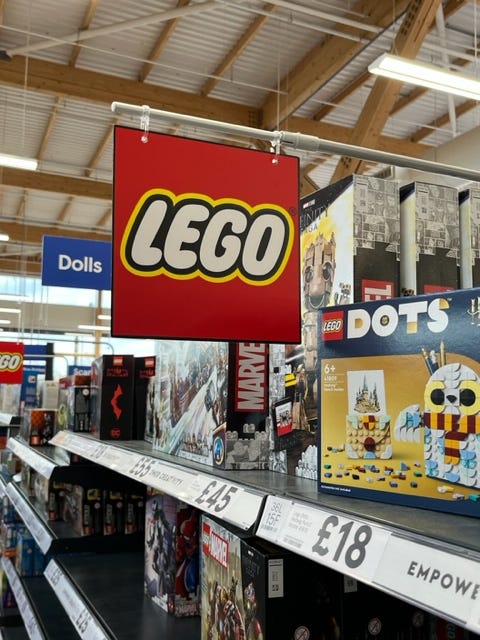

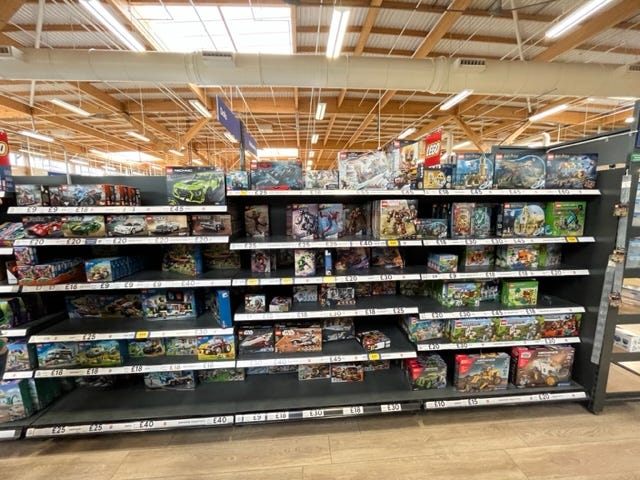

In baked beans, Heinz are competing with Branston. I’m a Branston fan, as are many it turns out (I love the fact they beat Heinz on taste tests regularly) yet Heinz has upwards of 68% market share. So I understand this jostling for position with greater shelf stocking clearly a good strategy for Branston. Greater availability + good product = more sales for sure. I predict their market share to grow. Maybelline having 2-3:1 ratio of shelf space over other beauty brands in the section will likely reflect in sales (dependent on other factors like fame/price/look etc). But beauty juggernaut and parent L'Oréal aren’t exactly going to go small here. Lego have their signage, dominating a few gondolas, it figures given the Group’s market leading position and often larger product size (boxes). I noticed their prices are above average given their premium status, so promotion strategies are in play (Clubcard prices for special offers), which leads nicely into the big one.
PRICE, PROMOTIONS & Clubcard
Supermarkets are very much akin to the ‘cathedrals of consumption’ of which sociologist George Ritzer spoke. The lure of the baked goods smell on entry, loss leaders, aisle ends, clearances, eye level techniques. It is all designed to seduce and drive sales. Of course though, the big one is PRICING. Price Promotions. Bundles. Price as a marketing lever can manifest in a number of ways and as a signifier of value (Cialdini), but typically in a supermarket, what you see are the varying price points (basic range through to Finest, with equivalent known branded goods throughout. PRICE is usually deployed as Promotions in these instances. They have Clubcard, one of the best ‘loyalty’ schemes in UK retail but one of the cardholder perks of recent months has been the advent of Clubcard Prices, a key driver of various product lines (as a punter, nothing suckers me in more than a yellow sticker).


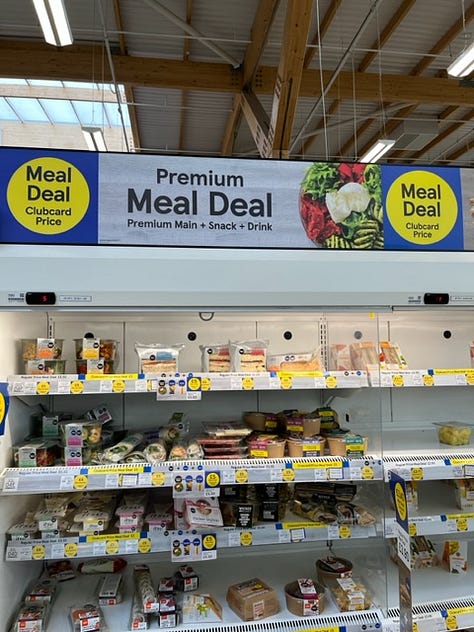
It is easy to see why, according to Reuters, approximately 95% of Tesco’s promotion are Clubcard driven. The price is denoted by a yellow sticker. We’ve all primed by yellow, we know it means a deal, stands out amongst the white. Potential clearance and such. But it isn’t a charity. It is a huge revenue channel. A multipack of Madri (12) likely sells less than a 4 pack, but the £12 feels like a deal even if not much less than £14; the quick maths pointing to £1 a bottle. Seems acceptable. The same with the wine. Only this time the Clubcard benefit is driving volume. 25% discount if you buy 6 bottles. Setting a behaviour for maximising the ‘hack’. Bundling at its best is the ‘Meal Deal’, the inaugural sandwich, snack and drink Combo serving office workers’ lunch everywhere as far back as I can remember. Not unique anymore, so they are again using the Clubcard to sell an even cheaper bundle than the default price.
A Little Behavioural Science
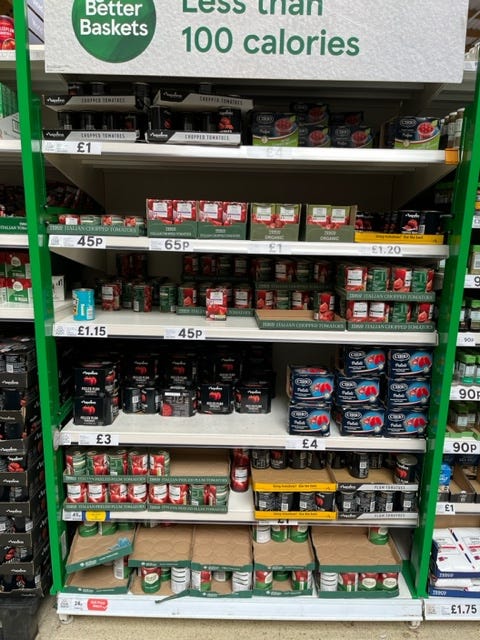
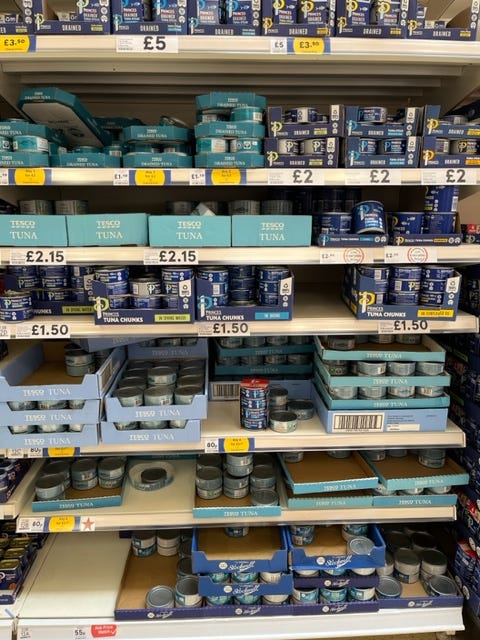

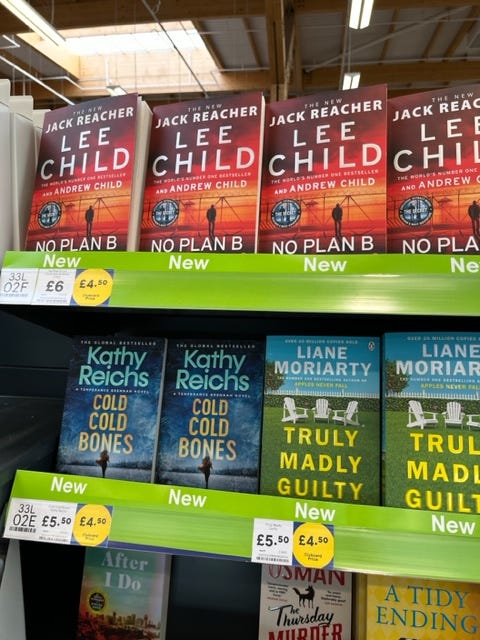
The use of consumer psychology and little nudging techniques evident everywhere. 4 more examples then I will stop with the photos. First 2 pics are tins. Store cupboard necessities, not huge margins but volume needed for retailers. The tomatoes example is framed with a header ‘Less than 100 Calories’ to add a benefit to the health conscious buyer, and the Tuna stand is a classic example of more profitable/ expensive lines at eye level. There are many examples of this but somehow Tuna made the cut. Notably, the cheaper stuff is almost always at the bottom, harder to reach. The eye level stuff, Clubcard sticker or not, is where it’s at. Layout is never an accident.
In the Books/News section, 2 levers here on the Jack Reacher Books; Adding the ‘New’ strip (nice feeling to get first look and early adoption) and the Clubcard Price (I’ll make the most of this as a regular). What failed to make the photo cut here of course is the Fiction Charts (social proof, everyone else is reading it), a retail bookshelf staple. Finally on this, the curious case of Price Match. Tesco seem obsessed with Aldi. I have had my thoughts on this before. I assume it has the desired effect (Tesco: ‘We know you go to Aldi but we’re matching your cheap shop prices, so don’t bother with them’) but sometimes wonder whether it’s that straightforward and there are unintended consequences (Consumer : ‘Why are they advertising Aldi?/Have they got a bee in their bonnet?/Is that legal?/But Tesco don’t bloody match on everything!’ Last one in a Dad voice). However I’m sure they have their reasons. It is an interesting one I am keen to hear more on from anyone in the know.
A Quick note on LOYALTY
I may cover this another time, especially on category level as it is arguable there is no such thing in consumer goods, mere preferences, and as multiple studies prove, light buyers are the target, and double jeopardy states the bigger companies and brands get the repeat ‘loyalty’ by default. But Clubcard is clearly a scheme that keeps me and 20 million other shoppers going back. I imagine it is like Boots and their Advantage cards; fending off others with their similar approach. The Clubcard Prices in particular, at a time where purse strings are tight just works. I am keen to see more data on this, especially on category level, but from a consumer perspective (I always joke that as a plugged-in marketeer I’m the easiest to sell to) it works on me very well. To caveat, I also go to Lidl for basics and Waitrose for certain specialties, so we’re not talking football club loyal, which is the issue of the term loyalty in marketing. But it is a sales driving scheme of certain lines there is no doubt, therefore my preference for many preferred items is the big Tesco!
CHECKOUT, THANKS FOR STOPPING BY
Stamps purchased. Point made. Camera roll ruined. But there was plenty to pique interest. I hope I’ve been able to share it in a way that makes sense. I personally find learning is easier in the context of real examples. Maybe your next grocery shop will have you thinking and questioning techniques, or looking at signage in a different way. But a word of advice, leave the camera out, you get funny looks!
SA
I hope you are getting a semblance of value out of this. If so, and you think any other marketer or business owner would, feel free to share/forward this to them. Also, follow me on LinkedIn, Twitter or even my company page. If you want to discuss working together, or simply something I’ve said, drop me a line. Thanks and happy reading!







